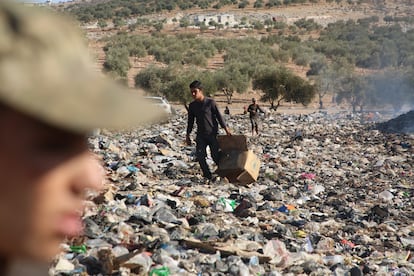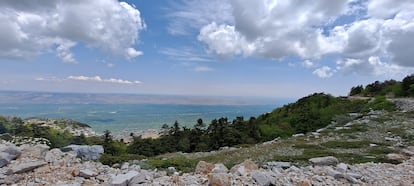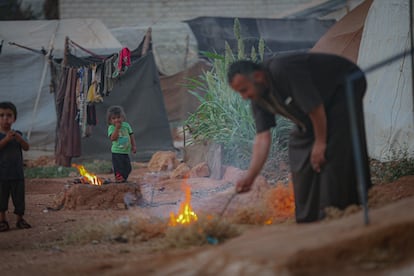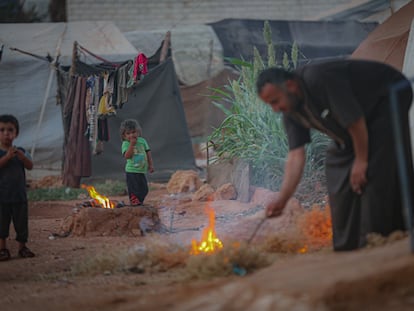How does war affect nature? Syria has lost 20% of its forests in 10 years
Explosions spark forest fires while the impoverished population is using trees as a source of fuel, which is driving desertification in the country, according to a study


Wars are, foremost, a human drama. Thousands of people see the tragedy of each conflict firsthand. But with a broader focus, it is possible to assess the wider impact of war. What happens to the trees, to the animals, to the ecosystem? A study has analyzed the situation in Syria, which has been in the grips of a bloody civil war since 2011. It found that the country has lost around 20% of its forests in a decade (from 2010 to 2019). On the one hand, artillery explosions spark forest fires that are difficult to put out due to the lack of resources and, on the other, internal refugees and the impoverished population use trees as a source of fuel, which in the long run may drive the desertification of the Mediterranean country.
“The effect of wars is not limited to the suffering of people, but also extends to nature and all living beings,” explains Angham Daiyoub, a 30-year-old Syrian who in 2018 traveled to Catalonia to start a master’s degree in forest management at the University of Lleida. She knows the suffering of the Syrian people first-hand: she lived through the conflict for several years, and her family continues to reside in Syria. Now in Spain, she set out to study how weapons and bombs have affected Syria’s environment.

Her research led to War and Deforestation: Using Remote Sensing and Machine Learning to Identify the War-Induced Deforestation in Syria 2010–2019, a study published in the scientific journal Land, which is focused on land systems and management.
The work is based on the study of Landsat and PALSAR satellite images with 30 meters of definition, which made it possible to differentiate between forested and non-forested areas. “We chose images from 2010, before the war started, from 2015 and 2019,” says Daiyoub, who is now a researcher at the Center for Ecological Research and Forestry Applications (Creaf) in Barcelona. Deforestation was analyzed using machine learning techniques based on models from previous years and the annual mapping of these areas.
“In conflict areas such as Syria, where field-based methods are challenging due to war conditions, remote sensing by satellite images is an appropriate instrument for analyzing the impact of the conflict on the landscape,” the study states.

The research shows that between 2011, when the war in Syria began, and 2019, the conflict devastated 19.3% of the country’s forest cover, which represents 63,700 hectares of its territory — an area equivalent to the city of Madrid.
The loss of forest cover has continued over time, with the damage concentrated in the coastal-mountain range of the northeast and around the capital, Damascus, which is located in the south. The highest rate of deforestation was observed between 2010 and 2015, when total forest cover fell by 11.5% (or 38,000 hectares). During the 2015-2018 period, a more gradual but constant decrease was also observed, with forest cover declining by 7.8%.

Daiyoub explains that the loss of forest cover is due to the war. “First of all, bombings and missiles spark fires in the forests that are difficult to put out, because there are no means to do so. Secondly, 90% of the population lives below the poverty line, and there are many internal refugees with very few resources, without access to gas or electricity, so they cut down the trees to cook, to warm themselves, and to sell the wood,” she says by phone. This unsustainable way of managing the forest means that the area cannot bounce back and becomes degraded.
Erosion and storms
The study highlights that the proximity of forested areas to roads, refugee camps and urban settlements has been one of the key drivers of deforestation. “Forests are fundamental for the ecosystem, for people, to combat water and air pollution. If they are cut down, all that is lost. But what’s more, many forested areas in Syria are in the mountains, and if they are left without trees, this can cause erosion when there are storms, changing the microclimate of the area and driving desertification and aridity,” says the researcher. “The part where there are the most forests is the Mediterranean, where there are all types of plants and animals, which are also affected by this situation,” she continues.

The research points out that in the decade before the war, Syria recorded positive annual rates of forest growth, according to the Syrian Monitoring of Agricultural Resources. In this period, the Food and Agriculture Organization of the United Nations (FAO) reported an increase of 119,000 hectares of forest cover in the country, a rise that was largely attributed to government forest recovery campaigns.
Daiyoub says that the conclusions of the study can be extrapolated to other conflicts. “It is estimated that two million hectares of forest were lost in the Vietnam War, around 20% of the forest mass in the south of the country. And in Ukraine it is also affecting protected areas, displacing animals, burning forests and degrading the soil,” she says. The researcher recalls that the Geneva Convention talks about protecting nature during conflicts and calls for sanctions on armed groups or countries that fail to comply with environmental laws during wars.
Sign up for our weekly newsletter to get more English-language news coverage from EL PAÍS USA Edition
Tu suscripción se está usando en otro dispositivo
¿Quieres añadir otro usuario a tu suscripción?
Si continúas leyendo en este dispositivo, no se podrá leer en el otro.
FlechaTu suscripción se está usando en otro dispositivo y solo puedes acceder a EL PAÍS desde un dispositivo a la vez.
Si quieres compartir tu cuenta, cambia tu suscripción a la modalidad Premium, así podrás añadir otro usuario. Cada uno accederá con su propia cuenta de email, lo que os permitirá personalizar vuestra experiencia en EL PAÍS.
¿Tienes una suscripción de empresa? Accede aquí para contratar más cuentas.
En el caso de no saber quién está usando tu cuenta, te recomendamos cambiar tu contraseña aquí.
Si decides continuar compartiendo tu cuenta, este mensaje se mostrará en tu dispositivo y en el de la otra persona que está usando tu cuenta de forma indefinida, afectando a tu experiencia de lectura. Puedes consultar aquí los términos y condiciones de la suscripción digital.
More information
Archived In
Últimas noticias
Most viewed
- Sinaloa Cartel war is taking its toll on Los Chapitos
- Oona Chaplin: ‘I told James Cameron that I was living in a treehouse and starting a permaculture project with a friend’
- Reinhard Genzel, Nobel laureate in physics: ‘One-minute videos will never give you the truth’
- Why the price of coffee has skyrocketed: from Brazilian plantations to specialty coffee houses
- Silver prices are going crazy: This is what’s fueling the rally










































